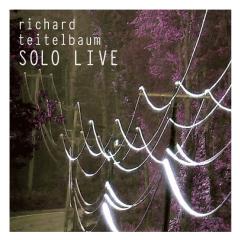SOLO LIVE / Richard Teitelbaum
Richard Teitelbaum (Kurzweil 2000 Sampler Keyboard, piano, bells, slide whistle, Crackle Box, laptop)
In 1973 composer/performer Richard Teitelbaum wrote a piece based on listening to and playing very softly with the distant sound of a highway as it filtered through the hills from several miles away. This experience became the basis of a score and a series of pieces called “Threshold Music”. The basic idea was to play so as to match the levels, timbres and amplitude envelopes of the sounds in the aural environment so carefully that the listeners could not really be sure what sound came from the environment and what from the “music”. The two pieces recorded here are an attempt to further elaborate on this concept.
“Threshold Symphonies” is all played on a Kurzweil 2000 Sampler Keyboard and the samples used include nature sounds, old Moog synth sounds, music of many friends, western and non-western musicians, sounds made with Max/MSP software, and others. The second work, "TBCi/bRT", is basically acoustic improvisation using piano, bells, slide whistle, and Crackle Box, and uses the soft sounds from outside (sirens) as integral aspects of the music.
Listen to the entire release on Soundcloud: soundcloud.com/mutablemusic
TRACK LIST
Threshold Symphonies (35’34”)
TBCi/bRT (14’28”)
REVIEWS
Grego Edwards, Gapplegate Classical - Modern Music Review, January 2013
The area of "new music" is a lively zone that takes on the "seriousness" of Western modern classical and some of its sounds and trajectories, but it may also incorporate elements of rock (as we saw in yesterday's post), jazz and improvisation.
On the improv-jazz side there has been especially fruitful combinations, starting principally with the influence of Cage and his works, then also Stockhausen. Groups like MEV and Il Gruppo set the stage for improvisatory avant music, and many others followed. And of course the "New Thing" in jazz saw much important, related music being made starting in the '60s with Coltrane, Coleman, Taylor, Cherry, Shepp and others.
Into all this came Richard Teitelbaum. an electronics-synthesizer improviser and composer who by the early '70s and his work with Anthony Braxton and others had established himself as an important figure in the music.
That he has not rested on his proverbial laurels can be heard on a new download-only release of his music, Solo Live (Mutable Music). For this outing Richard uses a laptop, a sampling synthesizer, piano and various other instruments to create a series of soundscapes that incorporates the natural environment with spacious electronic panoramas that invite the listener to travel fantastically-virtually to other places. He also holds forth on piano towards the end in dramatic ways.
The extent to which his music is improvised versus pre-planned isn't always clear, but the immediacy and personal quality of it certainly is.
Daniel Barbiero, Avant Music News, February 2013
The two pieces on this release are based on an ongoing experiment in playing to ambient sounds that composer/performer Richard Teitelbaum first conducted in the early 1970s. Teitelbaum in effect posits a zone of overlap between composed or improvised music and the accidental sounds of the environment surrounding it. Rather than contrasting the two types of sounds, Teitelbaum seeks to integrate them into a considered synthesis of the deliberate and the contingent.
Both pieces on the CD were recorded live at Baltimore’s An die Musik in April 2009. Threshold Symphonies, the long opening track, features the composer on Kurzweil 2000 sampler. Teitelbaum takes sounds from a wide variety of sources and constructs them into an audio mosaic in which they are sometimes recognizable and sometimes not, but always absorbing. Like a stain-soak abstract painting made of vivid colors, the piece is made up of multiple layers, with each layer leaving enough transparency to allow the underlayers to show through. One can hear the sounds of wildlife, human voices and musical instruments set within more ambiguous electronic sounds, some of which are reminiscent of the just-beyond-grasp murmurings of imagined voices heard in a hypnagogic state. Threshold Symphonies is followed by the shorter but still substantial TBCi/bRT, an improvisation for (mostly) acoustic instruments. The palette here is more constrained and is dominated by the piano, which sets out shimmering, sometimes discordant harmonies as landmarks throughout the course of the work.
This is a fine addition to Teitelbaum’s recorded oeuvre.

